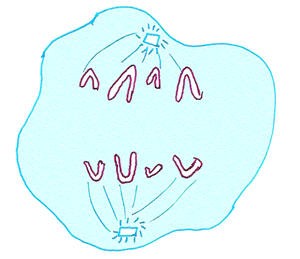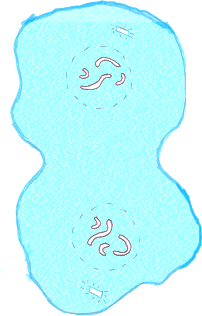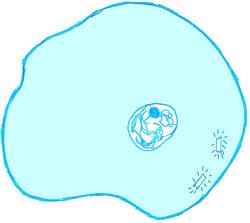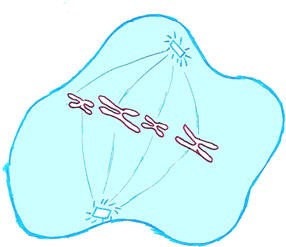Biology Questions: Phases Of Cell Cycle!

Biology questions: phases of cell cycle! Cells are the basic building block of living things, and that being said, they play a major role in our bodies. Do you know the different changes that a cell can undergo and the processes they use? How about you go through the quiz below and get to see how well you will do.
- 1.
Identify the phase of mitosis shown in this diagram.
- A.
Prophase
- B.
Metaphase
- C.
Anaphase
- D.
Telophase
- E.
Cytokinesis
Correct Answer
C. AnaphaseExplanation
The correct answer is anaphase. In anaphase, the sister chromatids of each chromosome separate and move towards opposite poles of the cell. This is clearly depicted in the diagram, where the chromosomes are seen being pulled apart and moving towards opposite ends of the cell. This phase is characterized by the elongation of the cell and the formation of the cleavage furrow.Rate this question:
-
- 2.
Identify the phase of mitosis shown in this diagram.
- A.
Prophase
- B.
Metaphase
- C.
Anaphase
- D.
Telophase
- E.
Cytokinesis
Correct Answer
D. TelophaseExplanation
The correct answer is telophase. Telophase is the final phase of mitosis, where the chromosomes have reached opposite poles of the cell and begin to decondense. The nuclear envelope reforms around the chromosomes, and the spindle fibers disassemble. Cytokinesis, the division of the cytoplasm, typically begins during telophase as well.Rate this question:
-
- 3.
Identify the phase of mitosis shown in this diagram.
- A.
Prophase
- B.
Metaphase
- C.
Anaphase
- D.
Telophase
- E.
Interphase
Correct Answer
A. ProphaseExplanation
The correct answer is prophase. In prophase, the chromatin condenses into visible chromosomes, the nuclear membrane begins to break down, and the spindle fibers start to form. This diagram likely shows these characteristic features of prophase, indicating that it is the correct phase.Rate this question:
-
- 4.
Identify the phase of mitosis shown in this diagram.
- A.
Prophase
- B.
Metaphase
- C.
Anaphase
- D.
Telophase
- E.
Interphase
Correct Answer
E. InterphaseExplanation
The diagram shows a phase where the chromosomes are not condensed or aligned at the equator of the cell. This indicates that the cell is not undergoing mitosis, as during mitosis the chromosomes would be condensed and aligned at the equator in metaphase, or moving towards opposite poles in anaphase. The phase shown in the diagram is interphase, which is the resting phase between cell divisions where the cell prepares for mitosis.Rate this question:
-
- 5.
Identify the phase of mitosis shown in this diagram.
- A.
Prophase
- B.
Metaphase
- C.
Anaphase
- D.
Telophase
- E.
Cytokinesis
Correct Answer
E. CytokinesisExplanation
Cytokinesis is the phase of mitosis shown in the diagram. Cytokinesis is the process in which the cytoplasm of a cell divides, resulting in the formation of two separate daughter cells. It occurs after the nuclear division (mitosis or meiosis) has taken place. In the diagram, the cell appears to be dividing into two separate cells, indicating the occurrence of cytokinesis.Rate this question:
-
- 6.
Identify the phase of mitosis shown in this diagram.
- A.
Prophase
- B.
Metaphase
- C.
Anaphase
- D.
Telophase
- E.
Interphase
Correct Answer
B. MetaphaseExplanation
The correct answer is metaphase because in the diagram, the chromosomes are aligned along the equator of the cell, indicating that it is in the middle stage of mitosis. In metaphase, the spindle fibers attach to the centromeres of the chromosomes and align them at the center of the cell before they are separated in the next phase, anaphase.Rate this question:
-
- 7.
Identify the phase of mitosis shown in this diagram.
- A.
Prophase
- B.
Metaphase
- C.
Anaphase
- D.
Telophase
- E.
Interphase
Correct Answer
E. InterphaseExplanation
The given diagram does not show any visible chromosomes or cell division. Interphase is the phase in the cell cycle when the cell prepares for division by growing, replicating its DNA, and carrying out normal cellular functions. Since the diagram does not depict any visible signs of mitosis, it is most likely representing the interphase stage.Rate this question:
-
- 8.
Tightly coiled DNA is referred to as
- A.
Chromatin
- B.
Chromatids
- C.
Chromosomes
- D.
Chromobodies
Correct Answer
C. ChromosomesExplanation
Tightly coiled DNA is referred to as chromosomes. Chromosomes are structures made up of DNA molecules that contain the genetic information of an organism. During cell division, the DNA coils tightly and condenses into visible structures called chromosomes. These chromosomes are responsible for the transmission of genetic material from one generation to the next.Rate this question:
-
- 9.
Sister chromatids separate during
- A.
Prophase
- B.
Metaphase
- C.
Anaphase
- D.
Telophase
- E.
Interphase
Correct Answer
C. AnaphaseExplanation
During anaphase, sister chromatids, which are identical copies of each chromosome, separate and move towards opposite poles of the cell. This is facilitated by the shortening of microtubules attached to the centromeres of the sister chromatids. As the microtubules shorten, the sister chromatids are pulled apart and towards opposite ends of the cell. This ensures that each daughter cell receives a complete set of chromosomes during cell division. Therefore, anaphase is the correct answer.Rate this question:
-
- 10.
The sister chromatids are held together by the
- A.
Centrioles
- B.
Centromeres
- C.
Centrosomes
- D.
Centrochores
Correct Answer
B. CentromeresExplanation
The sister chromatids are held together by the centromeres. Centromeres are specialized regions on the chromosomes where the two sister chromatids are attached. They play a crucial role in ensuring that the sister chromatids are properly aligned and segregated during cell division. The centromeres contain specific DNA sequences and proteins that form a complex structure called the kinetochore, which interacts with spindle fibers to facilitate chromosome movement. Without centromeres, the sister chromatids would not be able to stay connected and properly separate during cell division.Rate this question:
-
- 11.
The cell spends most of its time in which phase of the cell cycle?
- A.
G1
- B.
G2
- C.
S
- D.
Mitosis
- E.
Cytokinesis
Correct Answer
A. G1Explanation
The G1 phase is the first phase of the cell cycle, where the cell grows and carries out its normal functions. It is during this phase that the cell prepares for DNA replication in the S phase. The G1 phase is the longest phase of the cell cycle, and it is where the cell spends most of its time before progressing to the S phase and subsequent phases.Rate this question:
-
- 12.
Duplication of the DNA occurs in which of the following phases?
- A.
Prophase
- B.
S stage of interphase
- C.
G1 stage of interphase
- D.
G2 stage of interphase
- E.
Anaphase
Correct Answer
B. S stage of interphaseExplanation
DNA replication occurs during the S phase of interphase. Interphase is the phase between cell divisions where the cell prepares for division by growing and replicating its DNA. During the S phase, the DNA is duplicated, resulting in two identical copies of each chromosome. This ensures that each daughter cell receives a complete set of genetic information during cell division. Therefore, the correct answer is S stage of interphase.Rate this question:
-
- 13.
The spindle fibers connect to the centromeres during which pahse of mitosis?
- A.
Prophase
- B.
Metaphase
- C.
Anaphase
- D.
Telophase
- E.
Interphase
Correct Answer
B. MetaphaseExplanation
During metaphase of mitosis, the spindle fibers connect to the centromeres. This is the stage where the duplicated chromosomes align in the middle of the cell, forming a metaphase plate. The spindle fibers, which are responsible for separating the chromosomes, attach to the centromeres of each chromosome, ensuring that they are properly aligned before being pulled apart during anaphase.Rate this question:
-
- 14.
Duplication of the DNA occurs in which of the following phases?
- A.
Prophase
- B.
S stage of interphase
- C.
G1 stage of interphase
- D.
G2 stage of interphase
- E.
Anaphase
Correct Answer
B. S stage of interphaseExplanation
During the S stage of interphase, DNA replication takes place. This is the phase where the cell prepares to divide by duplicating its DNA. The DNA strands unwind and separate, and each strand serves as a template for the synthesis of a new complementary strand. This process ensures that each daughter cell receives an identical copy of the genetic material. Therefore, the correct answer is the S stage of interphase.Rate this question:
-
- 15.
Each half of the duplicated DNA is called a
- A.
Chromosome
- B.
Chromatin
- C.
Chromatid
- D.
Chromochore
Correct Answer
C. ChromatidExplanation
A chromatid is each half of a duplicated DNA molecule, which is joined together by a centromere. During cell division, chromatids separate and become individual chromosomes. Therefore, the correct answer is chromatid.Rate this question:
-
- 16.
The spindle fibers connect to the centromeres during which phase of mitosis?
- A.
Prophase
- B.
Metaphase
- C.
Anaphase
- D.
Telophase
- E.
Interphase
Correct Answer
B. MetaphaseExplanation
During metaphase of mitosis, the spindle fibers connect to the centromeres. This is a crucial step in the process of cell division, as the spindle fibers help to align and separate the duplicated chromosomes. In metaphase, the chromosomes are fully condensed and line up along the center of the cell, forming the metaphase plate. The spindle fibers attach to the centromeres of each chromosome, ensuring that they are properly positioned for separation during the subsequent phase of mitosis, anaphase. Therefore, the correct answer is metaphase.Rate this question:
-
- 17.
Each half of the duplicated DNA is called a
- A.
Chromosome
- B.
Chromatin
- C.
Chromatid
- D.
Chromochore
Correct Answer
C. ChromatidExplanation
A chromatid is each half of a duplicated DNA molecule, which is held together by a centromere. During cell division, chromatids separate and move to opposite poles of the cell, becoming individual chromosomes. Therefore, chromatid is the correct answer as it refers to each half of the duplicated DNA.Rate this question:
-
- 18.
Mitosis is important because it
- A.
Creates tissues
- B.
Replaces dead or damaged cells
- C.
Allows organisms to grow
- D.
Ensures each new generation is identical to the parent
- E.
All of these
Correct Answer
E. All of theseExplanation
Mitosis is important because it is responsible for creating tissues, replacing dead or damaged cells, allowing organisms to grow, and ensuring each new generation is identical to the parent. It plays a crucial role in the development and maintenance of multicellular organisms by enabling cell division and growth. Additionally, mitosis ensures genetic continuity and stability, as it produces genetically identical daughter cells. Therefore, all of these reasons contribute to the significance of mitosis.Rate this question:
-
- 19.
Mitosis is
- A.
The process of cell growth and division
- B.
The division of the cytoplasm
- C.
The division of the nuclear material
- D.
All of these
Correct Answer
C. The division of the nuclear materialExplanation
Mitosis is the process of cell division where the nucleus of a cell divides into two identical nuclei. During mitosis, the DNA in the nucleus replicates and then separates into two sets of chromosomes, each going to a different daughter cell. This division of the nuclear material ensures that each daughter cell receives an equal and complete set of genetic information. Therefore, the given answer "the division of the nuclear material" accurately describes mitosis.Rate this question:
-
- 20.
The cell spends most of its time in which phase of the interphase?
- A.
G1
- B.
G2
- C.
S
- D.
Mitosis
- E.
Cytokinesis
Correct Answer
A. G1Explanation
During the G1 phase of interphase, the cell grows in size and carries out its normal functions. It prepares for DNA replication and checks for any DNA damage or errors. This phase is also known as the "gap 1" phase, as it represents the gap between cell division and DNA replication. Therefore, it is reasonable to say that the cell spends most of its time in the G1 phase of interphase.Rate this question:
-
- 21.
Cancer is a out of control growth of cells
- A.
True
- B.
False
Correct Answer
A. TrueExplanation
Cancer is indeed an out of control growth of cells. In normal circumstances, the growth and division of cells are tightly regulated by the body. However, in the case of cancer, certain genetic mutations or environmental factors can disrupt this regulation, leading to the uncontrolled growth and division of cells. This uncontrolled growth forms a mass of cells called a tumor, which can invade nearby tissues and spread to other parts of the body. Therefore, the statement "Cancer is a out of control growth of cells" is true.Rate this question:
-
- 22.
A tumor is caused by uncontrolled mitosis. That tumor is full of unhealthy _________.
Correct Answer
cellsExplanation
A tumor is caused by uncontrolled mitosis, which means that cells are dividing and multiplying at an abnormal rate. These cells can be considered unhealthy because they are not functioning properly and can disrupt the normal functioning of surrounding tissues and organs.Rate this question:
- 23.
What do we call cells that grow out of control?
Correct Answer
cancerExplanation
Cells that grow out of control are called cancer cells. Cancer is a disease characterized by the uncontrolled growth and division of abnormal cells, which can invade and destroy nearby tissues. These cells can also spread to other parts of the body through the bloodstream or lymphatic system, forming secondary tumors. The unchecked growth of cancer cells can lead to various health problems and potentially be life-threatening if not treated.Rate this question:
- 24.
What is it called when the body eliminates unwanted cells?
- A.
Apoptosis
- B.
Mitosis
- C.
Interphase
- D.
G1
Correct Answer
A. ApoptosisExplanation
Apoptosis is the process by which the body eliminates unwanted or damaged cells. It is a programmed cell death that occurs naturally in multicellular organisms. During apoptosis, the cells shrink, condense their DNA, and break apart into small fragments. This process helps to maintain the balance and integrity of the body by removing old, unnecessary, or potentially harmful cells. Mitosis, interphase, and G1 are not related to the elimination of unwanted cells.Rate this question:
-
- 25.
Apoptosis is the bodies way of..... (click all that apply)
- A.
Eliminating old cells
- B.
Eliminating unhealthy cells
- C.
Eliminating unnecessary cells
- D.
Eliminating healthy growing cells
Correct Answer(s)
A. Eliminating old cells
B. Eliminating unhealthy cells
C. Eliminating unnecessary cellsExplanation
Apoptosis is a natural process in the body that eliminates old, unhealthy, and unnecessary cells. It is a programmed cell death mechanism that helps maintain the overall health and functioning of the body. By eliminating old cells, apoptosis allows for the regeneration and renewal of tissues. By eliminating unhealthy cells, apoptosis prevents the spread of damaged or potentially harmful cells. By eliminating unnecessary cells, apoptosis helps in the development and organization of different body structures. However, apoptosis does not eliminate healthy growing cells as they are essential for the body's growth and maintenance.Rate this question:
-
Quiz Review Timeline +
Our quizzes are rigorously reviewed, monitored and continuously updated by our expert board to maintain accuracy, relevance, and timeliness.
-
Current Version
-
Mar 22, 2023Quiz Edited by
ProProfs Editorial Team -
Nov 04, 2019Quiz Created by
Kyle Pearson








